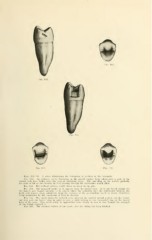Page 349 - My FlipBook
P. 349
ric. 183.
Fig. 182
^^^\
Figs. 1S2-1SG. A series illustrating llif fonnation of cavities in the bicuspids.
Fig. 182. An ordinary cavity beginning in tho mesial surface from which only a part of the
enamel rods have fallen from ihe area of beginning decay. The spreading on the surface probably
has gone as far as the cleaning by food passing through the embrasures would allow.
Fig. 183. The occlusal surface, which shows no decay in the pits.
Fig. 184. The prepared cavity as it apjwars from the mesial view. It is cut broad enough for
the buccal and lingual margins to be placed where the rounding into the embrasures between the
teeth will remove them sufficiently from the surfaces of the proximating tooth to insure cleanliness
being maintained by the excursions of food in chewing.
Fig. 185. The cavity from the occlusal view, showing the shallow mesial portion and the round-
ing step past the buccal cusp in order to give a wide margin to the recessional line of the buccal
horn of the pulp. This could safely be approached more closely in case it was thought the strength
of the filling required it.
Fig. 18ti. The occlusal surface uf the tooth after the filling has been finished.


